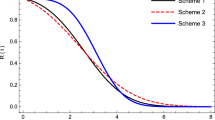Abstract
Birnbaum-Saunders models have largely been applied in material fatigue studies and reliability analyses to relate the total time until failure with some type of cumulative damage. In many problems related to the medical field, such as chronic cardiac diseases and different types of cancer, a cumulative damage caused by several risk factors might cause some degradation that leads to a fatigue process. In these cases, BS models can be suitable for describing the propagation lifetime. However, since the cumulative damage is assumed to be normally distributed in the BS distribution, the parameter estimates from this model can be sensitive to outlying observations. In order to attenuate this influence, we present in this paper BS models, in which a Student-t distribution is assumed to explain the cumulative damage. In particular, we show that the maximum likelihood estimates of the Student-t log-BS models attribute smaller weights to outlying observations, which produce robust parameter estimates. Also, some inferential results are presented. In addition, based on local influence and deviance component and martingale-type residuals, a diagnostics analysis is derived. Finally, a motivating example from the medical field is analyzed using log-BS regression models. Since the parameter estimates appear to be very sensitive to outlying and influential observations, the Student-t log-BS regression model should attenuate such influences. The model checking methodologies developed in this paper are used to compare the fitted models.
Similar content being viewed by others
References
Balakrishnan N, Leiva V, López J (2007) Acceptance sampling plans from truncated life tests from generalized Birnbaum-Saunders distribution. Commun Stat Simul Comput 36: 643–656
Berkane M, Kano Y, Bentler PM (1994) Pseudo maximum likelihood estimation in elliptical theory: effects of misspecification. Comput Stat Data Anal 18: 255–267
Birnbaum ZW, Saunders SC (1969) A new family of life distributions. J Appl Prob 6: 319–327
Collett D (2003) Modelling survival data in medical research. Chapman and Hall, London
Cook RD (1986) Assessment of local influence. J Roy Stat Soc B 48: 133–169
Cramér H (1999) Mathematical methods of statistics. Princeton University Press, Princeton
Davison AC, Gigli A (1989) Deviance residuals and normal scores plots. Biometrika 76: 211–221
Desmond A (1985) Stochastic models of failure in random environments. Can J Stat 13: 171–183
Díaz-García JA, Leiva V (2005) A new family of life distributions based on elliptically contoured distributions. J Stat Plan Infer 128:445–457 (Erratum: J Stat Plan Infer 137:1512–1513)
Dupuis DJ, Mills JE (1998) Robust estimation of the Birnbaum-Saunders distribution. IEEE Trans Rel 47: 88–95
Escobar LA, Meeker WQ (1992) Assessing influence in regression analysis with censored data. Biometrics 48: 507–528
Fang KT, Kotz S, Ng KW (1990) Symmetric multivariate and related distribution. Chapman and Hall, London
Fernandez C, Steel M (1999) Multivariate Student-t regression models: pitfalls and inference. Biometrika 86: 153–167
Galea M, Leiva V, Paula GA (2004) Influence diagnostics in log-Birnbaum-Saunders regression models. J Appl Stat 31: 1049–1064
Johnson NL, Kotz S, Balakrishnan N (1995) Continuous univariate distributions, vol 2. Wiley, New York
Kalbfleisch JD, Prentice RL (2002) The statistical analysis of failure time data. Wiley, New York
Klein JP, Moeschberger ML (1997) Survival analysis: techniques for censored and truncated data. Springer, New York
Lange KL, Little JA, Taylor MG (1989) Robust statistical modelling using the t distribution. J Amer Stat Soc 84: 881–896
Lawless JF (2002) Statistical models and methods for lifetime data, 2nd edn. Wiley, New York
Lee ET, Wang JW (2003) Statistical methods for survival data analysis. Wiley, New York
Leiva V, Barros M, Paula GA, Galea M (2007) Influence diagnostics in log-Birnbaum-Saunders regression models with censored data. Comput Stat Data Anal 51: 5694–5707
Leiva V, Barros M, Paula GA, Sanhueza A (2008a) Generalized Birnbaum-Saunders distribution applied to air pollutant concentration. Environmetrics 19 (in press) (doi:10.1002/env.861)
Leiva V, Riquelme M, Balakrishnan N, Sanhueza A (2008b) Lifetime analysis based on the generalized Birnbaum-Saunders distribution. Comput Stat Data Anal 52: 2079–2097
Leiva V, Sanhueza A, Angulo JM (2008c) A length-biased version of the Birnbaum-Saunders distribution with application in water quality. Stoch Environ Res Risk Assess (in press) (doi:10.1007/s00477-008-0215-9)
Lesaffre E, Verbeke G (1998) Local influence in linear mixed models. Biometrics 54: 570–582
Meeker WQ, Escobar LA (1998) Statistical methods for reliability data. Wiley, New York
Ortega EMM, Bolfarine H, Paula GA (2003) Influence diagnostic in generalized log-gamma regression models. Comput Stat Data Anal 40: 165–186
Owen WJ, Padgett WJ (1999) Accelerated test models for system strength based on Birnbaum-Saunders distribution. Lifetime Data Anal 5: 133–147
Owen WJ, Padgett WJ (2000) A Birnbaum-Saunders accelerated life model. IEEE Trans Rel 49: 224–229
Poon WY, Poon YS (1999) Conformal normal curvature and assessment of local influence. J Roy Stat Soc B 61: 51–61
Rieck JR, Nedelman JR (1991) A log-linear model for the Birnbaum-Saunders distribution. Technometrics 33: 51–60
Sanhueza A, Leiva V, Balakrishnan N (2008) The generalized Birnbaum-Saunders distribution and its theory, methodology and application. Commun Stat Theor Meth 37: 645–670
Saunders SC (1974) A family of random variables closed under reciprocation. J Amer Stat Soc 6: 319–327
Taylor J, Verbyla A (2004) Joint modeling of location and scale parameters of t distribution. Stat Model 4: 91–112
Therneau TM, Grambsch PM, Fleming TR (1990) Martingale-based residuals for survival models. Biometrika 77: 147–160
Tsionas EG (2001) Bayesian inference in Birnbaum-Saunders regression. Commun Stat Theor Meth 30: 179–193
Verbeke G, Molenberghs G (2000) Linear mixed models for longitudinal data. Springer, New York
Xie FC, Wei BC (2007) Diagnostics analysis for log-Birnbaum-Saunders regression models. Comput Stat Data Anal 51: 4692–4706
Author information
Authors and Affiliations
Corresponding author
Rights and permissions
About this article
Cite this article
Barros, M., Paula, G.A. & Leiva, V. A new class of survival regression models with heavy-tailed errors: robustness and diagnostics. Lifetime Data Anal 14, 316–332 (2008). https://doi.org/10.1007/s10985-008-9085-1
Received:
Accepted:
Published:
Issue Date:
DOI: https://doi.org/10.1007/s10985-008-9085-1




